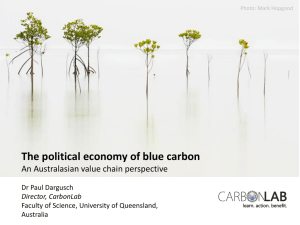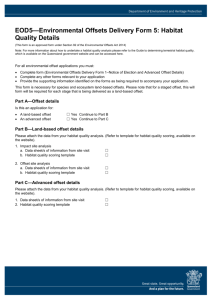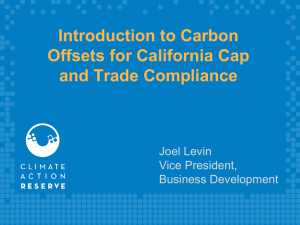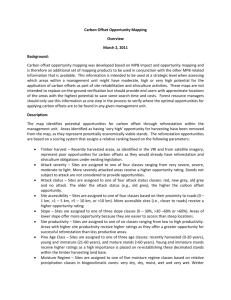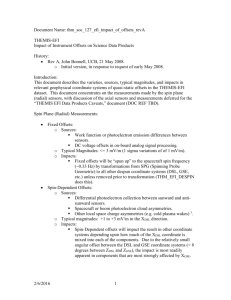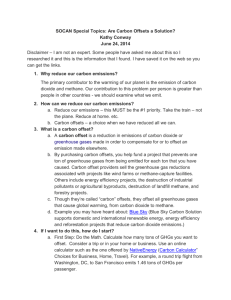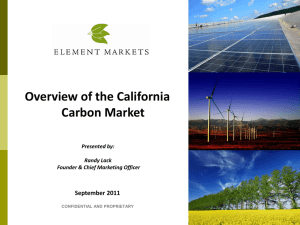Word - 152 KB - Department of the Environment
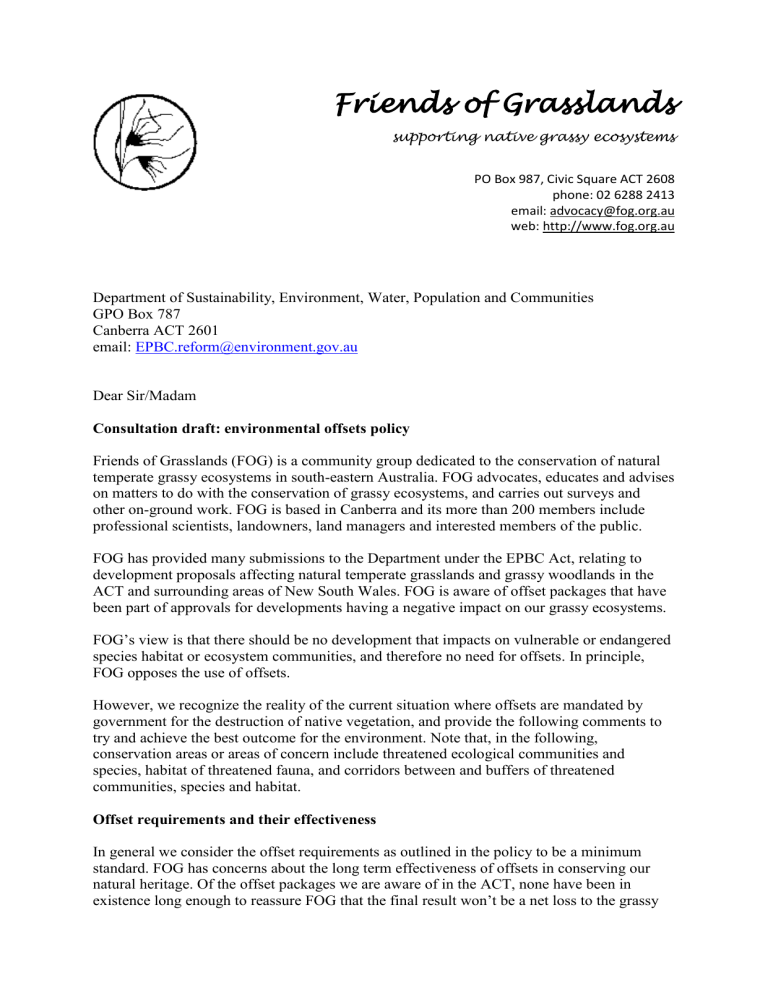
Friends of Grasslands
supporting native grassy ecosystems
PO Box 987, Civic Square ACT 2608 phone: 02 6288 2413 email: advocacy@fog.org.au web: http://www.fog.org.au
Department of Sustainability, Environment, Water, Population and Communities
GPO Box 787
Canberra ACT 2601 email: EPBC.reform@environment.gov.au
Dear Sir/Madam
Consultation draft: environmental offsets policy
Friends of Grasslands (FOG) is a community group dedicated to the conservation of natural temperate grassy ecosystems in south-eastern Australia. FOG advocates, educates and advises on matters to do with the conservation of grassy ecosystems, and carries out surveys and other on-ground work. FOG is based in Canberra and its more than 200 members include professional scientists, landowners, land managers and interested members of the public.
FOG has provided many submissions to the Department under the EPBC Act, relating to development proposals affecting natural temperate grasslands and grassy woodlands in the
ACT and surrounding areas of New South Wales. FOG is aware of offset packages that have been part of approvals for developments having a negative impact on our grassy ecosystems.
FOG’s view is that there should be no development that impacts on vulnerable or endangered species habitat or ecosystem communities, and therefore no need for offsets. In principle,
FOG opposes the use of offsets.
However, we recognize the reality of the current situation where offsets are mandated by government for the destruction of native vegetation, and provide the following comments to try and achieve the best outcome for the environment. Note that, in the following, conservation areas or areas of concern include threatened ecological communities and species, habitat of threatened fauna, and corridors between and buffers of threatened communities, species and habitat.
Offset requirements and their effectiveness
In general we consider the offset requirements as outlined in the policy to be a minimum standard. FOG has concerns about the long term effectiveness of offsets in conserving our natural heritage. Of the offset packages we are aware of in the ACT, none have been in existence long enough to reassure FOG that the final result won’t be a net loss to the grassy
ecosystems we are concerned about. While we acknowledge that intentions are generally sincere, we are also aware of the lack of knowledge of and problems with some of the rehabilitation attempts on grassy ecosystem sites. For this reason, we think that the size and scale of offsets needs to be generous until more certainty about the effectiveness of offsets is available.
We support scientific robustness in the entire process. It is important that the basis on which the government makes its decisions about development proposals and offsets be based on good ecological data. Where that data is not available, it needs to be collected and analysed before decisions about development proposals are made.
“Like for like”
The principle of “like for like” is very important and needs to be emphasized. “Like for like” should take into account flora, fauna and landscape function (not just flora). It also means that the offset area should be within the same region (from an ecological point of view) as the habitat being lost – an area being set aside in Western Australia should not be considered an offset for losses in Victoria, for example. The only exception we see to this principle might be where the offset habitat is rarer and of higher conservation value than the area being lost, and within the same region.
Characteristics of offset sites
The policy mentions the important environmental characteristics of the proposed site action as being its role and its quality. One aspect FOG would like to see added to the examples provided is connectivity – sites that connect other high quality sites are of particular importance in terms of the long term conservation of habitat. We note that it is covered in the offsets guide, but think that it should also be mentioned in the policy.
“No go” areas
FOG believes that there should be no development in high conservation areas, in other words that such areas should be declared “no go”. These are areas of high diversity (“core areas”), e.g. those previously noted in relevant assessments (such as action plans) compiled by any level of government. “No go” areas should be put aside for all types of ecosystems in
Australia, so that each type of ecosystem remains protected and represented in perpetuity.
While national parks and other conservation areas in principle fulfill this role, in practice pipelines, electricity lines and roads are still being put through some of these areas, with consequential degradation of the national park or conservation area involved through weed invasion and other problems. As well, some types of ecosystems are not well represented in the national reserve system. FOG also thinks that it is not sufficient to have an assessment method that places a high value on these areas, since a developer may decide to pay this cost and the resulting offset not deliver the desired outcome, leaving a net loss in the habitat in question. We think that the offsets policy should include provision for “no go” areas for each different type of ecosystem, and that these should be set aside in perpetuity with a moratorium on all development.
Landscape considerations
One concern we have is that, because development proposals are referred for decision on a piecemeal basis, consideration of development impacts and consequential offsets also occurs on a piecemeal basis. The result is sometimes “death by a thousand cuts”. In areas where continuing development proposals are likely, we think there should be consideration, on a landscape basis, of the impacts of current and likely future developments at the same time.
This would give a much clearer view of the total impact into the future, allowing maximal avoidance and mitigation of high conservation areas and thus reducing the need for offsets. In addition, landscape consideration of possible offsets is likely to be more effective and result in a better outcome for the environment.
Indirect offsets
FOG’s view is that offsets should primarily be for land protection and management (to enhance the endangered habitat), but a minor component might be long term research that is likely to be of benefit in managing or restoring endangered ecosystems or increasing endangered species populations. Research proposals should be specifically directed at species or ecosystem recovery, and obtaining good management outcomes leading to enhanced conservation of grasslands and grassy ecosystems. Where research is part of an offset package, there also needs to be commitment by the proponent to apply the research results on the ground, and resources allocated to do so (with all being part of the 25% indirect offset rather than coming out of the direct component of the offset package).
Timing of offsets
We can find no mention of the timing of offsets relative to the development in the policy. In our view, offsets must be in place before the development commences. For instance, land should be purchased, conservation covenants entered into, and funds put aside in trust account before any work on the development starts. A particular concern relates to rehabilitation of other areas as part of an offset package. In principle, rehabilitation should be at least commenced, if not completed, before development commences. This may give some idea of the likely success of the rehabilitation efforts and indicate whether the original assessment of risk associated with the offset is accurate or should be modified.
While rehabilitation can be very successful, there are many ecosystems which we do not understand fully and do not have good knowledge about how to regenerate. As well, regeneration can be affected by adverse environmental conditions such as prolonged drought, flood or bushfire. It is essential that any offset land be managed according to “bush regeneration” principles and that rehabilitation is done to an acceptable standard. However, while basic weed management can commence immediately, a bush regeneration team may need some time (at least one year’s seasonal cycle) to assess fully what is present on an offset site and how best to revegetate the site. For these reasons, the timeframes for revegetation of an offset site and for monitoring the success of such work are long – years rather than months
– which needs to be taken into account both in the timing of development commencement and the timeframe over which compliance is monitored.
“Net gain”
The species and ecosystems subject to the EPBC Act are generally vulnerable or endangered.
Consequently, we should be trying to expand their ranges, with the aim of eventually being able to take them off vulnerable or endangered lists. FOG’s view is that offsets should be aimed at “net gain” rather than maintenance of the status quo. “Net gain” means to, over time, increase the extent or improve the quality of habitat, and, for species, increase population sizes and improve breeding status. Aiming for net gain with respect to offsets would minimize the risk of net loss if an offset is only partially successful.
Compliance
We note that “6.1.5 A suitable offset must have transparent governance arrangements, including being able to be readily measured, monitored, audited and enforced”. Our concern with the process as outlined in the policy document is that it relies on the proponent reporting on the success of the offset. FOG’s view is that there must be a process, with oversight by experts, in place to track each offset and take corrective action if needed, and that this process needs to be independent and should include long term monitoring of the offset.
The policy mentions varying the conditions of approval if the offsets are not delivering the desired outcome. As well, we believe that penalties (e.g. fines and bonds) must be included in an offset agreement and applied for non-compliance. If non-compliance occurs, then there has been a net loss to the environment and to future generations. Penalties need to be sufficient to be a true deterrent.
Offsets guide
In the Offsets Calculator (from the Environmental Offset Assessment Guide) under Land
Tenure and Management, Habitat Condition is described as “must be good or better”. We are uncertain about what this means when Condition of Habitat Impacted is described as “low, medium or high”. It would be clearer if both measures used the same terminology.
The Direct Offsets Points Menu makes no mention of the length of time an offset is for. We suggest that bonus points be awarded when resources are committed to management and rehabilitation of offset areas into the long term. In many cases, the development for which the offset is being offered results in total destruction of the original habitat. In principle, in these cases the proponent should not only protect the offset area in perpetuity, but should also commit to maintaining it in good condition over the long term. Once a reasonable time and level of resources for rehabilitation is determined using scientific principles, any commitment by the proponent past this level should be recognised and encouraged.
In response to the question about the appropriateness of the proposal that 75 per cent of offset points must be earned from direct offsets, FOG’s view is that this percentage should not be any lower; if anything it should be higher. Our concern with indirect offsets is that in fact they will result in no benefit and in fact a net loss for the ecosystem or species in question, pushing it closer to extinction.
In terms of quantifying the impact categories of low, medium, high and of determining appropriate weightings of offset points for particular actions, FOG considers that this needs to
be discussed and determined by independent scientists and ecologists who have a broad understanding of endangered and vulnerable ecosystems and species across the country.
Conclusion
In conclusion, FOG reiterates its view that there should be no destruction of high quality native vegetation and habitat. We remain concerned that the use of offsets will result in a net loss of native species and ecosystems across the landscape.
Sincerely yours
John Fitz Gerald
President
19 October 2011
